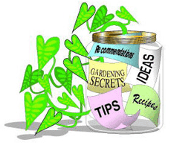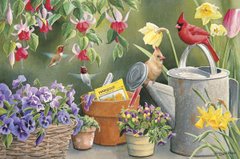

Have you done some action plan to save our planet?
Well today we've changed alot of our light bulbs to flourescent, to save money and to contribute to saving our planet.
Go Green Action:

Composting is a good way to aid your plants, your yard, and yourself. Choose a location that is easy to reach and that is partially isolated. It may be in full sun, part shade, or full shade, and should be well drained. Decide how formal you want the compost heap to be. A simple pile will work well, but you or your significant other may want it more contained.
Start your compost pile with grass clippings, leaves, weeds, wood chips, or kitchen waste. Alternate layers of compost ingredients. Make a layer of about 6 to 10 inches of brown leaves, then a layer of grass clippings at about the same thickness. Brown material should be about 75% and green material should be about 25%. As the layers are put down, wet each one thoroughly. To increase the speed of composting, incorporate some farm manure or commercial fertilizer. Kitchen wastes, such as fruits, vegetables, coffee and tea grounds, and eggs shells, may be used.
The pile should be turned every two weeks or so, and you should have good compost in six to eight weeks. Turning the pile is also a good way of working out frustrations and burning extra calories. If you do not want to turn the pile, the compost will be ready in about one to two years. It is better to avoid dairy products, fats, or meats, as the compost pile will smell very bad.
After the compost has become garden ready, spread it in the flower beds or in the garden to improve the soil and fertilize the plants.
FROM: Andy Andrews, Smith County Master Gardener
You can learn more from this site:
Things you can help to save our Planet:
1. Use programmable thermostat
2. Make compost
3. Use soaker hoses to water your garden, add a water timer
4. Plant vegetables and flowers
5. Wash clothes in cold water, if possible
6. Hang dry them outside.
7. Use newer appliances, for energy savings
8. Car pool or use public transit, or walk
9. Turn off electronics that are not in use
10. Use brown bags for packing your lunch
11. Change shower head to a water saving kind
12. Participate in recycling program
13. Try not to use pesticide spray for your garden.
and there's more if you like to help: ( oh please do.)
Check these sites for Go Green information.
http://www.gogreen.com/
http://canada.gc.ca/main_e.html
http://www.nrcan-rncan.gc.ca/media/newsreleases/2007/200704c_e.htm
http://www.nrcan-rncan.gc.ca/com/ctp/index-eng.php
http://magazines.ivillage.com/goodhousekeeping/myhome/howtos/articles/0,,284554_697918,00.html
10 novel ways to go green for Earth Day
http://www.ctv.ca/servlet/ArticleNews/story/CTVNews/20070420/earthday_tips_070421/20070420/
Updated Fri. Apr. 20 2007 2:55 PM ET
Nicole Tomlinson, Special to CTV.ca
You've heard of steps you can take to help the planet -- like taking transit, turning off lights and recycling paper -- so many times you have them memorized. Here are 10 less obvious ways to go greener this Earth Day, Sunday April 22.
1. Keep it electronic
Take advantage of one way that technology is eco-friendly and lose your paper trail. Receive and pay your bills online, subscribe to magazines and papers over the Web, and think twice before firing up that printer. Do you really need a hard copy?
If you're wary of having your information sent electronically for privacy reasons think again. Identity theft, a growing crime which affects thousands of Canadians every year, commonly happens after someone gets a hold of your mail. Opening a mail box or sifting through discarded paper is much easier for most than cracking the Web security that companies use to guard your personal information.
Get the information you want online and on demand, and remember, you always have the option to print something if you need it. One tree produces approximately 85,000 sheets of paper. If each Canadian used 50 pieces less a month, we could save over 230,000 trees a year.
2. Tone down take-out
Next time you want your favorite restaurant dish, think twice before picking up the phone and ordering take-out or delivery. Getting food to go creates a lot of unnecessary waste.
Though some restaurants use recyclable plastic or paper products, others use Styrofoam. Although it isn't made with ozone-depleting CFCs anymore, the white containers still contain benzene, a known carcinogen and styrene, a neurotoxin. Styrofoam often ends up in the garbage because people don't know it can be recycled, and styrene leaches into the soil and water, showing up in nuts and produce that have never come into contact with the plastic. It's even banned by law in restaurants in San Francisco.
Even if your take-out waste is neurotoxin-free and recyclable, it's still hard to clean the food off of it and stick it in the blue box without attracting scavengers -- so it may end up in the sealed garbage can anyway.
3. Don't be a part of over-packaging
Fast-food restaurants, retail stores and grocers in Canada package, and re-package the products we buy. All the paper and plastic used in this often-redundant process helps Canadians throw out the 1.8 kilograms of garbage every day, clinching the title for most waste produced per capita in the world.
There are a few simple ways to fight the packaging fad -- just say no to double-bagging.
Fast-food places tend to give you more napkins than you'll (hopefully) need. Instead of throwing them out, take them with you and keep them in your purse, your car, or at home to use.
Another easy way to avoid double bagging is to keep supermarket produce bag-free until the check-out, especially single items. The cashier will bag them for the journey to your crisper, where they can be stored package-free.
4. Green up appliances
The amenities in our homes make our busy lives more comfortable and manageable. They're also resource-gluttons. Each Canadian uses 36,000 litres of water a year, enough to fill 180 bathtubs, just using the toilet. There are a few ways to save energy and water at home without foregoing flushing.
Pack the dishwasher, and don't pre-rinse. This appliance uses 40 litres of water each time it cleans our dishes, so wait until it's full to run it. Pre-cleaning uses more water, and usually isn't necessary. If your dishwasher doesn't wash your dishes, it's not doing its job.
Wash your clothes in warm water, not hot. It gets clothes just as clean and less hot water means less energy used heating it. Fabrics don't hold up as well if they're washed on the hot setting, so you'll get less wear out of your favorite t-shirt and create more waste when you throw your faded clothing out more often.
5. Think Canadian cuisine
Go green without going bust. Buying food cultivated locally means that it hasn't been transported far by carbon-emitting vehicles. It also means that it's usually fresh without being chemically-treated or heavily packaged for a long journey.
Visit your local farmer's market, and pay attention to how far your grocery store purchases traveled to get on the shelf.
If you go for exotics, try to find organic options. These products are certified to be free of pesticides and hormones. Most developing countries that ship produce north, like bananas, pineapple, strawberries and green beans, are loading them with more pesticides than ever, and around 20 per cent is sprayed only to make the produce look appealing.
6. Don't wipe away forest
Saving carbon-converting trees isn't the only way that buying recycled tissue fights global warming: it also conserves Canada's northern wetlands, where tons of carbon are stored in peat. The boreal forest is vast, covering 35 per cent of the country, and is the largest ancient forest left in North America. It's being logged to make paper products, including 190 billion sheets of the most popular brand names of tissue in the world.
When the boreal forest is clear cut, peat moss dies, releasing carbon into the atmosphere. The ecosystem is one of the largest land carbon storage units in the world. You can help conserve this fighter of climate change by buying recycled tissue paper.
7. Clean without polluting the water
Most people would be afraid to swallow the products they use to clean, but they don't think twice about pouring them down the drain and into their drinking water supply. Households are the largest single source of hazardous waste in Canada. Some 54,000 tons of household cleaners, equal to the weight of 9,000 blue whales, are used nationwide every year.
But non-toxic products can clean your house without dirtying your water. Buy eco-friendly cleaners or make then yourself with easy-to-find ingredients that cut dirt and germs just as well. For a general, all-purpose cleaner to get you started, try baking soda paste and water, or salt and water mixed with a little vinegar.
8. Re-vamp recycling
Even with recycling programs, about 70 per cent of the waste rotting in Canada's landfills could have been blue binned, but wasn't. Take a moment to think about every item you throw out. Ask yourself if parts of it could be recycled, or composted. Not sure if it's recyclable or not? Check the label or your municipal government's website.
Another quick way to minimize waste is to choose re-usable items over disposable ones: Tupperware instead of plastic wrap or bags, plastic yogurt or margarine containers to store food, and linen napkins instead of paper, to name a few.
9. Go vegetarian once a week
Most Canadians eat meat at least twice a day, and get more than the 2 or 3 serving sizes that Health Canada suggests. And producing meat isn't resource cheap. For example, it takes 85 times more water to produce a kilogram of beef than the same amount of potatoes.
Livestock farms also pollute. On average, 21 per cent of a Canadian's water pollution comes from eating meat from high-density farms. Going meat-free just one day a week can reduce your personal pollution contribution by over 20 kilograms a year.
If you're concerned about getting the nutrients you need without eating meat, Health Canada recently came out with a new food guide showing protein and nutrient-rich portions for vegetarian alternatives, including legumes, shelled nuts and tofu.
10. Know who's in the know
Companies are also dealing with doing business in the face of climate change. In January of this year, The Global 100 Greenest Companies were unveiled. Innovest research gauged more than 1,800 companies worldwide to compile a list of the 100 most able to adapt to climate change. Some big names include Coca Cola, Walt Disney, Nike and Royal Dutch Shell.
Well I hope you start your Go Green action plan soon. And if you have more ideas, share them here.

Happy Blogging and spread this news.





























































